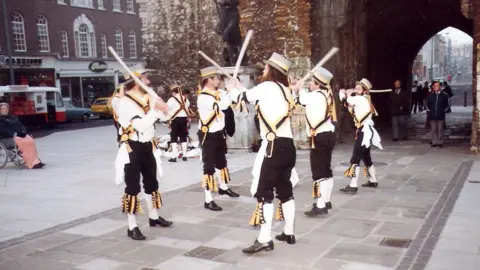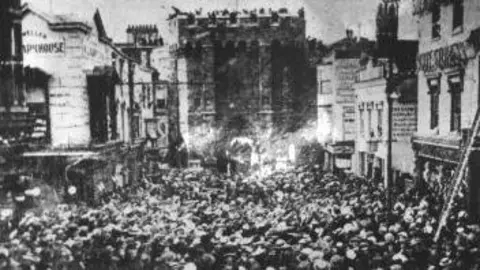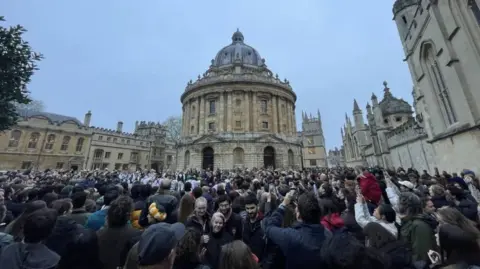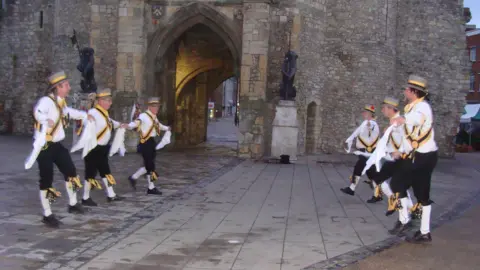How a city's May Day traditions 'faded away'
 King John's Morris Men
King John's Morris MenThere was a period of time when thousands gathered at a town's medieval centrepiece to welcome the start of May.
Archive newspaper articles from May Day in the now city of Southampton show the festival drew large crowds in the late 19th and early 20th Century.
The event still appeals to the masses in Oxford but its popularity has waned in other parts of the country in recent years.
Mark Stoyle, a professor of early modern history at the University of Southampton, told the BBC why he thinks the tradition has "faded away".
 SCC Libraries
SCC LibrariesHe said the exact origins of May Day were not known.
"The earliest records of it are in the 1200s, so it probably stretches back way beyond then," Mr Stoyle said.
From then on there was a lot of evidence of celebrations taking place across the country.
He said: "Usually young men and women would go out into the countryside on the eve of May Day and they would gather up all sorts of flowers and blossoms and they would bring them back to decorate their own communities.
"That's the classic bringing home of the May, you go out into the woods and you bring back the May.
"It's like bringing back the promise of summer."

Many traditions have formed since that point, including one of the most famous, which happens in Oxford.
The Magdalen College choir sing the traditional hymn Hymnus Eucharisticus at 06:00 each 1 May from the top of one of the city's great towers.
Mr Stoyle believes this tradition "struck a chord" with the people of Southampton, who felt inspired to start a similar event.
"In the 1880s someone said 'wouldn't it be a great idea to have a Southampton choir singing from a public place here?'" he said.
 SCC Libraries
SCC LibrariesThe Hampshire Independent noted at the time that "the May Choir" had "inaugurated the month with singing from the Bargate" since 1882.
In an article about the 1887 event, the newspaper stated "there must have been something like 1,500 people assembled to hear the singing".
Interestingly, there were even complaints back then about the tradition's waning popularity.
Wartime celebrations
The event continued even during World War One as the Western Daily Press reported on 3 May 1915.
It said: "Several thousand people witnessed the May Day celebration from the top of Bargate."
The paper made reference to the war, saying "khaki uniforms" were "greatly evident" and "the occasion acquired added interest as it was made one for intercession for men engaged on the King's service".
The celebration continued after the war as images in the Daily Mirror on 2 May 1919 show.
"The Mayor of Southampton climbs to the top of the Bargate and looks down on the crowd below," it said.
Images show then-mayor Sir Sidney Guy Kimber and his wife taking part in the annual May Day traditions and distributing primroses.
Mrs Kimber can be seen giving flowers to the choirboys.
Modern May Day
Prof Mark Stoyle reflected on the how traditions "faded" in modern times and put this down to a lack of organisation and societal changes.
"I think it would be a lovely tradition to revive," he said.
"Southampton is lucky to still have the medieval Bargate and it's a really nice way to bring people together, so I think it would be great if they brought it back."
 King John's Morris Men
King John's Morris MenJohn Miller, from Southampton, is a member of King John's Morris Men, which has been welcoming in the summer from the Bargate every May Day morning since 1978.
Almost 50 years on and he said they still try to keep the day "alive".
He admitted that when they first started dancing there in the 1970s and '80s "there was virtually nobody there".
Now "dozens" of people gather to watch the traditional performance.
"Our country has a massive wealth of folk traditions," Mr Miller said.
He said it was "vitally important" to keep these alive and to pass them on to future generations.
You can follow BBC Hampshire & Isle of Wight on Facebook, X (Twitter), or Instagram.
